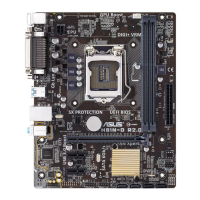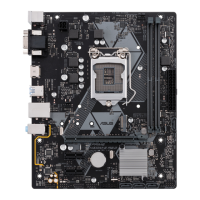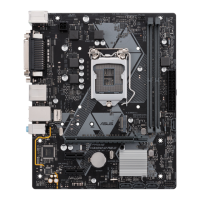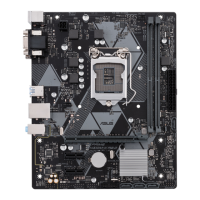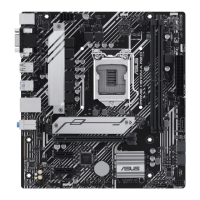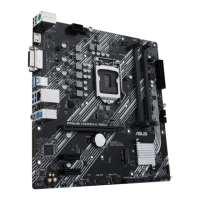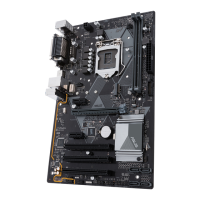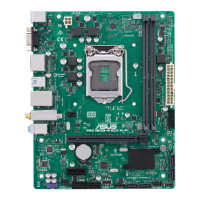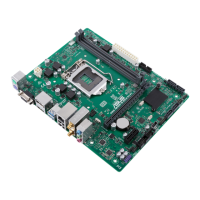Do you have a question about the Asus H81M-D R2.0 and is the answer not in the manual?
Precautions for safe installation, handling, and operation of the motherboard.
Outlines the structure and content of the user guide for easy navigation.
Essential safety measures to take before installing motherboard components or changing settings.
Understanding the motherboard's physical layout and ensuring chassis compatibility.
Guidance on orienting the motherboard correctly within the chassis for installation.
Instructions on where to place screws to secure the motherboard to the chassis.
A diagram identifying major components and connectors on the motherboard.
A list of connectors, headers, and slots with their corresponding page numbers for detailed info.
Detailed, step-by-step guide for safely installing the CPU into the socket.
Instructions for mounting the CPU heatsink and fan assembly correctly.
General information about the DDR3 DIMM sockets and compatible memory modules.
Explains memory installation, dual-channel setup, and compatibility notes.
Step-by-step instructions on how to properly install a RAM module into a DIMM slot.
Procedure for physically installing an expansion card into a slot.
Steps for software and BIOS configuration after installing an expansion card.
Details on the two PCI Express x1 slots and their supported peripherals.
Information about the primary PCI Express x16 slot for graphics cards.
Instructions on how to reset BIOS settings to default values using the CLRTC header.
Identifies and explains the function of all ports on the motherboard's rear I/O panel.
Explains the purpose and connection of various internal motherboard headers.
Details the connection for the chassis's front panel audio input/output ports.
Instructions for connecting CPU and chassis fans to the motherboard headers.
Information on connecting internal USB 2.0 ports using the provided headers.
Details on connecting the main ATX power supply cables to the motherboard.
Explains the connection for the chassis-mounted system warning speaker.
Describes the SATA 3Gb/s ports for connecting storage devices.
Details the SATA 6Gb/s ports for faster storage device connections.
Explains connections for power buttons, LEDs, and reset switches to the motherboard.
Guidance on installing compatible operating systems on the motherboard.
Details on the drivers, software, and utilities included on the motherboard support DVD.
Procedures for backing up, restoring, and updating the motherboard's BIOS.
Utility for automatic updates of motherboard firmware, drivers, and BIOS.
Tool for updating BIOS directly from USB without an operating system.
Auto-recovery feature to restore BIOS from corruption using support media.
Utility for updating the BIOS within a DOS environment.
How to enter and navigate the BIOS setup utility for system configuration.
Method to access BIOS during the Power-On Self Test (POST).
Alternative methods to access BIOS after the system has started booting.
The default BIOS interface offering basic system information and quick settings.
The advanced BIOS interface for detailed system configuration and tuning.
Contains various legal and compliance statements for the product.
Details the device's compliance with the Federal Communications Commission rules.
Information regarding compliance with Industry Canada regulations.
Statement regarding compliance with Japan's voluntary control council for interference.
Korean warning for broadcast communication equipment, concerning interference.
Information on compliance with European chemical substance regulations.
Details ASUS's commitment to recycling and environmental protection programs.
| Non-ECC | Yes |
|---|---|
| Internal memory | 16 GB |
| Memory channels | Dual-channel |
| Memory slots type | DIMM |
| Number of memory slots | 2 |
| Supported memory types | DDR3-SDRAM |
| Supported memory clock speeds | 1066, 1333, 1600 MHz |
| Processor socket | LGA 1150 (Socket H3) |
| Processor manufacturer | Intel |
| Compatible processor series | Intel Celeron, Intel Pentium |
| Intel® Core i3/i5/i7/i9 series | i3-4xxx, i5-4xxx, i7-4xxx |
| Maximum number of SMP processors | 1 |
| Number of SATA connectors | 4 |
| Number of Parallel ATA connectors | - |
| USB 3.2 Gen 1 (3.1 Gen 1) connectors | 0 |
| Supported storage drive interfaces | SATA II, SATA III |
| USB 2.0 ports quantity | USB 2.0 ports have a data transmission speed of 480 Mbps, and are backwards compatible with USB 1.1 ports. You can connect all kinds of peripheral devices to them. |
| Ethernet interface type | Gigabit Ethernet |
| Cooling type | Active |
| Component for | PC |
| Power source type | ATX |
| Motherboard chipset | Intel® H81 |
| Audio output channels | 7.1 channels |
| Motherboard form factor | micro ATX |
| Windows operating systems supported | Windows 7 Enterprise, Windows 7 Enterprise x64, Windows 7 Home Basic, Windows 7 Home Basic x64, Windows 7 Home Premium, Windows 7 Home Premium x64, Windows 7 Professional, Windows 7 Professional x64, Windows 7 Starter, Windows 7 Starter x64, Windows 7 Ultimate, Windows 7 Ultimate x64, Windows 8, Windows 8 Enterprise, Windows 8 Enterprise x64, Windows 8 Pro, Windows 8 Pro x64, Windows 8 x64, Windows 8.1, Windows 8.1 Enterprise, Windows 8.1 Enterprise x64, Windows 8.1 Pro, Windows 8.1 Pro x64, Windows 8.1 x64 |
| BIOS type | UEFI AMI |
| ACPI version | 2.0a |
| BIOS memory size | 64 Mbit |
| Cables included | SATA |
| Depth | 183 mm |
|---|---|
| Width | 226 mm |
